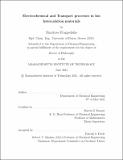Electrochemical and Transport processes in Ion Intercalation materials
Author(s)
Fraggedakis, Dimitrios
DownloadThesis PDF (57.60Mb)
Advisor
Bazant, Martin Zdenek
Terms of use
Metadata
Show full item recordAbstract
Moving towards an environmentally sustainable society, energy storage becomes increasingly important. As has been widely recognized with the recent Nobel prize in chemistry, ion intercalation materials play an essential role in the state-of-the-art energy storage technologies, such as Li-ion batteries, as they are used everywhere around us; from the phones we use to the cars we drive. Intercalation-based energy storage devices can be thought as an electrochemical plant where processes related to transport phenomena (solid/liquid diffusion) and kinetics (ion insertion/extraction) take place. Even though extensive research has been done in understanding and optimizing the solid and liquid diffusion properties of the active materials and electrolytes, very few studies have been conducted in elucidating the fundamentals of ion insertion kinetics that take place at interfaces. Additionally, most ion intercalation materials tend to phase separate into ion–rich and –poor phases under ion insertion/extraction. Our understanding, however, on the effects of intercalation rates, applied electric fields and the microscopic nature of the reactions on the resulting phase morphologies is not complete. The main goal of this thesis is to comprehend, from a very basic level, the reasons that limit the performance of energy (e.g. Li-ion batteries) and information (memristors) storage technologies, and provide insights and engineering solutions for next generation intercalation-based devices that deliver high efficiency and optimal performance.
In the first part of the thesis, I develop the theory of coupled ion-electron transfer, where both the ion and the electron have to be transferred in a concerted way. By using simulations and experiments I demonstrate the use of the theory on ion intercalation, the fundamental process of Li-ion batteries. In the second part of this thesis, I derive a simple theory that unifies the behavior of all phase-separating electrode materials under driven ion insertion. The proposed criterion predicts the non-equilibrium phase morphology during ion insertion, which is validated by phase-field simulations of single Li𝑥CoO2 (LCO) particles, in situ optical imaging of single Li𝑥C6 (graphite) particles undergoing transitions between stage 1 (𝑥 = 1) and 2 (𝑥 = 0.5) at different rates, and collapse of all the available literature data for single-particle imaging of 3 LCO, graphite and Li𝑥FePO4. In the third part, I investigate the influence of different electron transfer kinetics on the thermodynamic phase stability of open driven systems. By using non-equilibrium thermodynamics, I demonstrate different ways to control the morphology of interfaces during operation, e.g. ion intercalation, electroplating, corrosion, and conclude that the electronic density of states of the electron donor is key on engineering the morphology of electrochemical interfaces. In the last part of the thesis, I focus on the effects of electric fields on the thermodynamic stability of ion intercalation materials. There, I develop the theory that describes how electric fields induce metal-to-insulator transitions and lead to effective dielectric breakdown, which is essential in (non-)volatile memristive devices.
In summary, this thesis constitutes a comprehensive study of how kinetics, phase separation and transport phenomena affect the non-equilibrium response of ion intercalation materials. The theoretical, computational, and experimental results of the present work can serve as a guideline for engineering ion intercalation systems suitable for fast-charging energy storage devices and non-volatile neuromorphic chips. In addition to its practical aspect, the present thesis expands the boundaries of what is known in terms of reaction kinetics, phase-separating driven open systems, and non-equilibrium thermodynamics.
Date issued
2021-06Department
Massachusetts Institute of Technology. Department of Chemical EngineeringPublisher
Massachusetts Institute of Technology